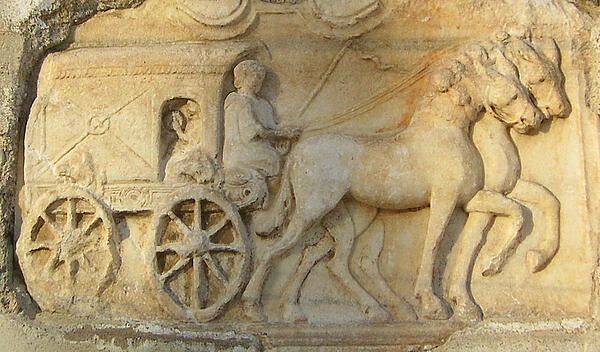The Roman Empire and Trade
Trade was an essential part of life for the Romans - the empire was worth a great deal and trade managed to bring in a lot of that money. Rome’s population was one million and this amount required many different things which were brought back through trading. By importing goods from other countries they could raise their living standards and have more luxuries.
Trade routes covered the Roman Empire along with sea routes covering the Mediterranean and Black Seas, and many different land routes which used the roads that the Romans Trade had built. The two main motives for building roads was trade and moving of the Roman Army.

Ostia was the most significant port since it was the closest main one to Rome; it sat at the River Tiber’s mouth and was just 15 miles away from Rome. A lot of ships sailed between Ostia and Carthage, a major city in North Africa, and this journey took a total of three to five days. Ostia also had ships arrive there from France and Spain. The entire goods could be transferred to Rome very quickly since they were carried in barges to the city and up to the River Tiber once the slaves moved the items across from the merchant ships over to the barges. Ostia did in fact become very involved in Rome’s downfall when it was captured in AD 409 by Alaric the Goth, which cut off Rome’s important food supply.
The Romans did as much as possible to ensure the safety of sea journeys, for instance by building lighthouses as safe harbours and docks, and the Roman Navy made attempts for the safety of the Mediterranean Sea from pirates.
Rome made trading as simple as could be - only a single currency was used and no complicating customer dues. An additional welcome proved to be trade due to the Empire’s peaceful years. It was fundamental to the Empire’s success - when it collapsed, the trade throughout lands which previously made up the Roman Empire also collapsed. Merchants also found the Mediterranean became a danger zone as there no authorities were available to control pirate activity as far north as the English channel.
They used their road network to transport from one country to another:
- Silver with Britain which was used to make jewellery and coins, and wool to make clothes
- Clothing dyes from the south-eastern area of the empire and spices for flavouring food
- Silk from the Far East (China) to produce fine clothes
- Cotton from Egypt
- Wild animals to be used in gladiator fights from Africa
Spain, France, the Middle East and north Africa were the main trading partners. The Romans also imported beef, corn, glass, iron, lead, leather, marble, olive oil, perfumes, timber, tin and wine.
Britain sent out lead, woollen products, and tin - in return they imported wine, olive oil, pottery and papyrus. The British traders depended on the Romans for the Empire’s security - when it collapsed and Europe seemed to be taken over by Barbarians, traders didn’t have the guarantee that their goods would get through. Without the added power of Rome, no one would be eager to buy produce from Britain and other areas in Europe.
See also: How was Rome Governed, The Roman Empire
MLA Citation/Reference
"The Roman Empire and Trade". HistoryLearning.com. 2025. Web.
